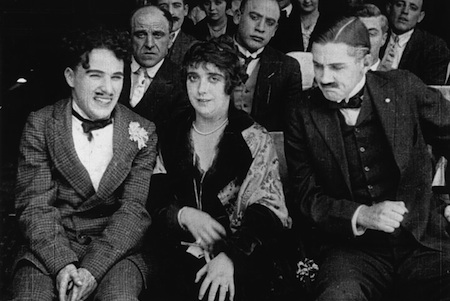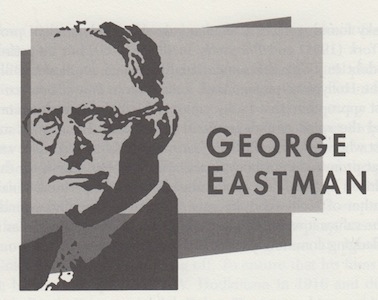Born: July 12, 1854, Waterville, NY
Died: March 14, 1932, Rochester, NY
Eastman improved on Edison’s idea by making celluloid flexible so It could be wound on a spool.
—Donald Heraldson
A bank clerk with a passion for amateur photography, George Eastman purchased a camera at age twenty-three and began learning how to master the difficult wet-plate process that had become the standard for capturing images. After much frustration with these messy wet plates, Eastman invented his own solution: he made a prototype machine that coated glass plates with a dry chemical emulsion that was light-sensitive. This new process was welcomed enthusiastically by photographers, and the dry plates sold well. However, the heavy glass plates proved too cumbersome to carry in quantity, and their higher price made them even less desirable. Eastman needed a better product.
A key development was the 1884 Eastman patent on a paper film, provided on a roll and made to wind through a camera so that it collected pictures as it moved past the lens. Originally, these pictures were captured one at a time; photographers had to expose an image, wind the film forward, then expose another image. The invention would launch the successful company known today as Eastman Kodak and make possible the Brownie snapshot camera, introduced in 1888.
The Brownie was the first portable camera simple enough to be used by amateurs, and it released thousands of new photographers to the world. These snapshot experts simply sent the cameras back to Eastman for developing, and they were promised complete service through the advertising catchphrase “You push the button, we do the rest.” Sure enough, the Eastman company churned out thousands of photos the first year.
The entrepreneurial Eastman, looking for more ways to sell his roll film, was happy to provide some in response to inquiries from the pioneering spirit of Thomas Edison’s workshop, Laurie Dickson, who was experimenting with recording moving images. The paper film broke easily when Dickson attempted to send it through his viewing machine, and he told Eastman that he would require a strong film that could mold to a cylinder for rotating through the viewer. Eastman, to his regret, could not oblige.
Luckily, Dickson had heard about a process discovered by the Reverend Hannibal Goodwin of Newark, New Jersey, for making a strip of film on a nitrocellulose or “celluloid” base, coated with a photosensitive emulsion. Dickson told Eastman of the Goodwin invention and suggested that this might be better suited to his needs. Dickson explained that the rolls should ideally by 35mm wide and perforated. Tempted by the prospect of supplying the regular needs of Edison’s blossoming film business, Eastman did some testing and soon found a way to manufacture the first flexible transparent film on a celluloid roll. By 1889, the film was commercially available, and the specifications have changed little since.
The greatest achievement of the Eastman company, however, was its ability to keep pace with the changes in the film industry, despite its explosive growth in other markets, such as amateur photography. It is the only vendor to have supplied the film industry continually since its inception (except for a four-year period, when Eastman’s participation in the Motion Picture Patents Company prevented him from servicing certain customers). Eastman gave the film business his unflagging support, investing heavily in any technology that was deemed important to the advancement of film. He was skillful at hiring talented inventors to keep his products of the highest quality. His organization was swift in edging the competition and quick to raise capital when needed. His support in the infancy of motion pictures was vital, particularly in seeing that busy producers from Edwin Porter to Mack Sennett received steady shipments of film stock.
In 1902, a significant patent case threatened Eastman’s company. Hannibal Goodwin sued Eastman over the infringement of his 1887 patent on flexible celluloid film. The case, which dragged on until 1914, possibly altered the course of film history. It is clear that Goodwin knew of the limited shelf life of his nitrate film, and he had made significant steps toward developing an alternative. But the eleven-year legal battle with Eastman tapped the resources he needed to manufacture a better film stock, and an accident ended Goodwin’s life prematurely. Nitrate developers continued to be the standard for film processing—and today present the greatest threat to the preservation of classic films.
Again in the 1920s, a patent dispute plagued Eastman; when Hollywood embraced the Technicolor process invented by Herbert T. Kalmus, Eastman hurriedly prepared his company for competition in color film stock. However, Technicolor enjoyed a lengthy patent protection period that effectively locked out Eastman for decades. So while Eastman waited for Kalmus’s reign to end, the engineers at Kodak labs devised a system that substantially lowered the cost of developing three-color film. On the heels of the patent deadline, Eastman representatives made backlot deals with most of Hollywood’s studios, and by 1953, producers were abandoning the Technicolor process for Eastman Color. George Eastman, however, never lived to see its success. After a long bout with illness, he committed suicide in 1932.
The legacy of Eastman carried on. Shortly after his death, the George Eastman House was founded to become a permanent archive of international motion pictures; today, one of the oldest film archives in the United States, it houses over seventeen thousand cinematic treasures, including silent films, photographs, lobby cards, advertising posters, music sheets and scripts. In the late 1950s, Kodak did for wishful young home-movie makers what it had done for photographers with the Brownie snapshot camera: the company released a low-cost 16mm Instamatic movie camera and projector for amateurs, giving hope to a generation of dreamers that included Steven Spielberg, George Lucas and Francis Ford Coppola.
Innovations such as celluloid roll film and amateur movie cameras illustrate the profound influence of Eastman. He spent a good portion of his time and resources on perfecting the technical aspects of film and promoting its worldwide use. His organization was a cornerstone of the industry that would provide cameras and film made at his Rochester, New York headquarters for more than a hundred years. George Eastman’s commitment to motion pictures, coupled with a competitive drive to dominate its equipment and materials, earns him a top position among film influencers simply because his dedication to the industry was instrumental in the rapid progress of the art form.
To read all the republished articles from ‘The Film 100,’ go to Reintroducing the Film 100 here on Keyframe.





